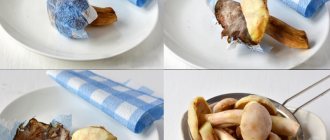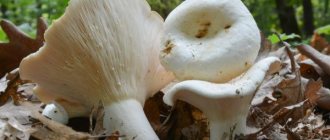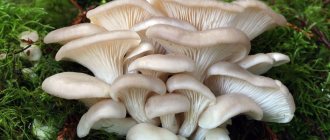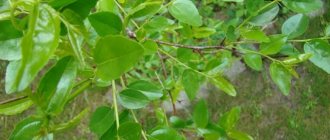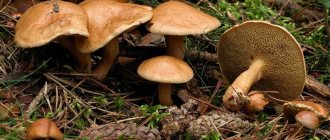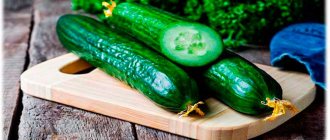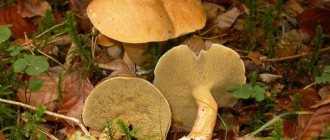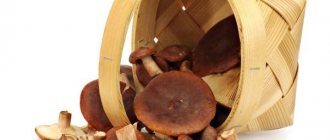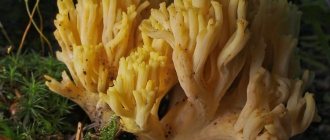Chemical composition and calorie content of butter
The pulp of fresh and processed mushrooms contains a huge amount of valuable substances. Among the main ones are:
- ascorbic acid and vitamin PP;
- vitamins A and B;
- iron, phosphorus and zinc;
- copper and iodine;
- manganese and potassium;
- fiber;
- amino acids;
- mono- and disaccharides.
Butter mushrooms contain a lot of amino acids and vitamins.
Most of the protein in the product is up to 2.4 g. Carbohydrates in butter milk are present in a volume of 1.7 g, and fats are only 0.7 g. The nutritional value of mushrooms is very low - only 19 calories per 100 serving G.
Nutritional characteristics
Like most forest mushrooms, boletus mushrooms are 90% water. But this does not mean that they lack nutrients. On the contrary, they are rich in fiber, proteins, minerals, vitamins, and carbohydrates. Some believe that boletus mushrooms are even superior to porcini mushrooms in their beneficial properties.
An analysis of the proteins that make up butter has shown that they are almost identical to animal proteins. Mushrooms contain essential amino acids, but their quantity and composition vary depending on the age and soil in which they grew. Most proteins can be found in young mushrooms, more precisely in their caps, since the legs are less saturated with nutrients. It is also interesting that a kilogram of dried buttermilk contains almost three times more proteins than the same amount of beef or fish [3]. And although, according to nutritionists, the body absorbs mushroom proteins worse than meat proteins, properly prepared boletus is an excellent source of useful components.
Another important element of mushrooms is chitin (the same one that mollusk shells are made of). A high concentration of this substance is found in the stems of mushrooms, which makes them tougher than the caps. Because of this, some people refuse this part of the product, which is not always justified. Chitin is a type of plant fiber that, in addition to well-known benefits (quickly satisfies hunger, regulates the functioning of the digestive tract), absorbs and removes toxins and other harmful substances from the body.
If we talk about vitamins, boletus belongs to the record-holder products for the content of B vitamins. In terms of the concentration of these beneficial substances, they can compete with fish, liver, grains and butter. In addition to B-substances, boletus contains no less useful vitamins A and. And at the same time, they remain an extremely low-calorie product: 100 g of fresh buttermilk contains no more than 19 kcal [4].
What are the benefits of boletus mushrooms for humans?
Butternuts are valued for their pleasant crunchiness and mild taste. But, in addition, they have numerous beneficial properties. In particular, mushrooms:
- improve the functioning of the immune system and increase the body’s resistance to viral diseases;
- help fight inflammation as they prevent the proliferation of pathogenic bacteria;
- improve liver function due to lipid content and normalize intestinal motility;
- have a positive effect on the reproductive system and increase libido in men;
- lower blood glucose, therefore beneficial for diabetes mellitus;
- strengthen the walls of blood vessels and prevent the development of atherosclerosis and heart disease;
- lower cholesterol levels and help fight the tendency to blood clots;
- increase hemoglobin and prevent anemia;
- accelerate regeneration processes in tissues;
- have a beneficial effect on brain activity and the nervous system.
Since boletus improves metabolic processes and stimulates cellular renewal, consuming them is useful for the prevention of cancer.
For women
The beneficial properties of boletus mushrooms for women include, first of all, a positive effect on the nervous system. Mushrooms help cope with stress and neuroses and regulate night sleep. You can also use them in case of malfunctions of the reproductive system; they will normalize hormonal levels and help increase libido.
Mushrooms are useful not only for general health, but also for maintaining youth and beauty. With regular use, they improve skin tone and strengthen hair.
Oil butter evens out the emotional background and improves reproductive functions
Important! Oils regulate blood pressure and relieve headaches. Including them in your diet is useful if you are prone to migraines.
For men
Representatives of the stronger sex are recommended to consume boletus to prevent cardiovascular diseases. Mushrooms improve the tone of blood vessels and heart muscle, reducing the risk of early heart attacks and strokes. Since fruiting bodies contain a lot of protein, they can be eaten to gain and maintain muscle mass.
Mushrooms protect the male reproductive system from failures. If you add boletus to your diet from time to time, there will be no problems with potency.
During pregnancy
Healthy oils are not recommended for use by women who are pregnant. Despite all their valuable properties, mushrooms can cause great harm to the expectant mother or baby in the womb. Even if a woman does not suffer from allergies or chronic diseases, butter can always turn out to be stale, especially when salted or pickled. The potential danger of the product outweighs the benefits, so it is better to exclude mushrooms from the diet.
For nursing women
Women who are breastfeeding are advised to include boletus back into the menu only 6 months after giving birth. In the early stages, mushrooms will lead to digestive upset in a newborn; his sensitive intestines will not be able to absorb the product.
It is better not to eat boletus during pregnancy - possible poisoning is too dangerous
For children
Butter can be very beneficial for children. They saturate the body with vitamins and minerals, improve the functioning of the nervous system, and have a positive effect on intelligence and memory.
But at the same time, mushrooms are not offered to children under 7 years of age. Fruit bodies contain a substance called chitin, which is almost not digested by the body, and therefore can lead to flatulence, nausea and digestive disorders.
Attention! Mushrooms have certain contraindications. Before including them in your child’s diet, you should consult a pediatrician.
When losing weight
The low-calorie product can be consumed on a diet. It saturates the body with high-quality protein and quickly quenches the appetite, and does not affect the figure if taken in moderate dosages.
Recommended reading: Benefits of boiled beets for the body
It is even allowed to use a mono-diet on mushrooms. In this case, you need to eat no more than 300 g in boiled form per day. You can add some vegetables to the oils; be sure to drink more water. Continue the diet for no more than 2 days; if you eat only mushrooms for a long time, this will lead to poor digestion and constipation.
Low-calorie boletus can be eaten on a diet after boiling
Rules for collecting and processing oil
In order for boletus to bring maximum benefit and be perfectly absorbed by the body, it is necessary to follow a few simple rules regarding their collection and processing. Firstly, as already noted, mushrooms need to be collected in proven places, near which there are no roads or industrial enterprises. Secondly, it is important to remember that boletus quickly becomes unusable, so they need to be processed immediately. Thirdly, it is better to cut the fruiting bodies finely and subject them to mandatory heat treatment.
We hope that after reading our article, boletus dishes will bring you the greatest benefit and pleasure.
Are pickled boletus healthy?
For the winter, mushrooms are often marinated with spices and spices to extend their shelf life. Such snacks also have benefits; they contain a maximum of vitamins and beneficial microelements. In particular, pickled butter:
- strengthen the immune system and improve metabolic processes;
- accelerate digestion when the stomach is sluggish;
- relieve muscle pain and fight inflammation;
- improve blood composition and remove toxins;
- have a beneficial effect on the nervous system and brain function.
At the same time, you need to include them in your diet with caution - spices and vinegar in the product can be harmful for diseases of the digestive system. If you have serious problems with the kidneys, stomach or liver, then it is better to avoid pickled mushrooms.
Pickled boletus is beneficial if it is of high quality and fresh.
Advice! Even in the absence of contraindications, daily norms of no more than 100 g of product per day must be observed.
Features of the influence on the human body
Mushrooms affect different categories of people differently.
For adult men and women
The main benefit of butter is that they help fight infectious diseases.
If pathogenic microorganisms are present in the body, they will be destroyed and the development of infection will be prevented. Oils remove uric acid, preventing the development of gout and kidney stones.
It contains lecithin, which helps the nervous system of adult women and men function properly. It prevents the development of stress and increased cholesterol levels.
Protects liver cells from damage. Butter contains protein that can replace animal meat.
Natural aphrodisiacs contained in boletus increase libido levels. This is more pronounced in men.
Their erections improve, which prolongs the duration of sexual intercourse. Women get aroused faster and get more pleasure from intimate relationships.
Despite the benefits, these mushrooms can cause harm:
- slow breakdown of proteins: this is a fairly heavy and difficult to digest food, which is prohibited for people with diseases of the digestive system;
- such mushrooms quickly deteriorate, which increases the risk of poisoning;
- chitin in the fungus negatively affects metabolism.
Pregnant and nursing
Pregnant and breastfeeding women are not recommended to consume boletus. Their body is weakened and more sensitive to toxic substances, so the product can be harmful.
This will negatively affect the health of both the baby and the mother. The milk will acquire a specific taste that the child will not like. There is a high risk that dangerous substances will enter a child’s fragile body along with milk.
Despite the vitamins and minerals contained in mushrooms, lactating and pregnant women should not consume them, so as not to risk either their health or that of their child.
What are the benefits for children?
Mushrooms are beneficial for children because they contain vitamins and minerals that can strengthen the body. The baby's nervous system will work better. He won't be capricious.
But the benefits for children are limited to this. The harm in this case outweighs the benefit. Mushrooms are difficult to digest and contain chitin, which disrupts the digestion process in children.
It can cause bloating and heaviness in the stomach, nausea. This product should not be used by people under 16 years of age.
In old age
In old age, mushrooms can benefit the nervous system.
It works harmoniously, helps to avoid stressful conditions thanks to oils.
With the help of the substances they contain, you can remove toxins from the body and lower cholesterol levels.
But if you have chronic pathologies of the digestive system in old age, you cannot use this product.
The harm may consist in the fact that the oil will cause an exacerbation of the disease, causing vomiting, weakness, and dizziness.
If the immune system is weak, poisoning may cause illness, which will cause a life-threatening situation.
Allergy sufferers
If you have an allergic reaction to certain foods, including mushrooms, avoid consuming boletus. An allergy sufferer's body is too sensitive .
In mild cases of allergies, a rash and dizziness are possible; in severe cases, anaphylactic shock can occur and swelling of the mucous membrane and skin occurs.
Breathing becomes difficult, which can lead to a life-threatening condition.
Use of boletus in medicine
Butter can be found not only in culinary recipes, but also in home medicine. Mushrooms effectively remove harmful substances from the body and have anti-inflammatory properties. All this allows them to be used for treatment.
For example, a tincture has a good effect on joint diseases:
- 200 g of fresh mushrooms are poured with cognac in a glass jar;
- keep in a dark place for 2 weeks;
- Take the strained product 1 small spoon.
You need to drink the tincture twice a day, diluting it with 50 ml of water.
Tincture of boletus helps with arthritis and rheumatism
Mushroom extract is beneficial for psoriasis. In this case, unwashed mushrooms are placed in a jar, tightly closed with a lid and left for 20 days, and then the dark liquid formed at the bottom is filtered. There is no need to drink it; apply the product to the skin twice a day.
Possible dangers
The special structure of mushrooms and their porous structure contribute to the rapid absorption of harmful substances from the air. For this reason, even edible boletus collected in environmentally unfavorable areas turns into poisonous. They cause poisoning, accompanied by stomach upset, nausea, vomiting and fever. It is important to know that the cap absorbs the most toxins.
Improperly prepared mushrooms are poorly absorbed by the body, so it is important to adhere to the rules for preparing butter. In addition, it is advisable to exclude this product from the diet of young children and people with digestive disorders and chronic diseases of the gastrointestinal tract (3).
The use of oil in cosmetology
The antibacterial properties of mushrooms are beneficial for those prone to acne and acne. If you dry the fruiting bodies and then grind them, the resulting powder can be added to homemade masks and lotions for skin care. You can mix the product with oils, cucumber pulp, potatoes; in all cases, mushrooms will be beneficial.
We recommend reading: Potatoes: beneficial properties and contraindications
For example, this mask helps well with dry skin:
- clean fresh boletus is placed in a jar, filled with water, 2 large tablespoons of alcohol and half a glass of vegetable oil are added;
- Leave the product in a dark place for 2 days;
- strain before use.
Oil-based lotion helps improve skin tone
Use homemade lotion with mushroom extract to wipe the skin twice a day. The product moisturizes the epidermis, quickly increases firmness and elasticity.
Useful properties of oil
- Butter is an excellent low-calorie product. They have only 19 kcal per 100 grams. fresh mushrooms. In addition, they are digested rather slowly, which means they leave you feeling full longer. For all these reasons, butternut squash is a great food for those looking to lose weight.
- Due to their high protein content, boletus serves as a good meat substitute for people following a vegetarian diet.
Harmful oil and contraindications
If used carelessly, mushrooms can cause harm. First of all, they contain chitin, a polysaccharide that is not absorbed by the body. If taken in small portions, the substance will have a cleansing effect and help remove toxins from the intestines. But if you eat too much butter, it will lead to bloating and abdominal pain.
Pickled and salted fruit bodies can be harmful. They should not be consumed in large dosages if you have problems with the stomach, kidneys or liver; jars contain a lot of salt and hot spices. Mushrooms infected with botulism pose a great danger; bacteria can appear if preparation and storage conditions are violated.
The benefits and harms of an ordinary oiler depend on its original quality. When picking mushrooms yourself, you need to look for mushrooms only in ecologically clean areas - away from roads, factories and landfills. Before you put the fruiting body in the basket, you need to be sure of its species - false duplicates can be poisonous.
For some diseases, you need to completely stop eating oil. Contraindications include:
- gastrointestinal ailments in acute stages;
- serious liver and kidney diseases;
- allergic intolerance to mushrooms;
- pregnancy and lactation.
You should not eat mushrooms if you have a severe cold. Butternuts are not offered to children under 7 years of age; such food will be too heavy.
Harm
Oilseeds will be beneficial or harmful depending on where they are collected and how they are consumed. Autumn mushrooms often grow near industrial areas. Due to the porous structure of the cap, boletus accumulates radiation (cesium) and other harmful chemicals (aeropollutants). The result of eating mushrooms collected in an unfavorable ecological zone is poisoning.
Mushrooms should be prepared with caution. The consequences of collecting old mushrooms, as well as violating the rules of heat treatment, lead to dire consequences. Mushrooms affected by worms cause allergies.
Important! It is recommended to remove the skin before preserving. It can be a source of growth for the bacteria Clostridium botulinum, the causative agent of botulism.
Recommendations for processing and use
The taste and benefits largely depend on how well the mushrooms are processed:
- Fruiting bodies should be prepared immediately after collection. Fresh boletus is not stored for a long time; after just a few hours, it begins to lose its freshness.
- During the processing process, it is customary to remove the sticky film from the fruiting bodies, which accumulates toxic substances, especially if the mushrooms are old and have grown in the forest for a long time. The film can be peeled off with a knife, and to make it easier to separate, it is recommended to first scald the butter with boiling water and immediately pour cold water over it 2-3 times.
- The leg is usually cut off during cooking. Its taste is worse than that of the cap, and besides, it contains the maximum amount of chitin.
The skin from the butterdish cap can be easily peeled off with a knife if you first scald and cool the mushroom
You can prepare boletus according to a variety of recipes. Most often, mushrooms are boiled, fried in a frying pan, salted or pickled, and made into caviar. The product retains its greatest benefits when boiled and salted; when frying, most of the beneficial substances are destroyed by high temperature.
To ensure that the health benefits and harms of butternut squash remain in balance, it is recommended to eat mushrooms no more than 3 times a week - constant consumption of protein foods can lead to constipation. The daily norm is about 200 g, and if we are talking about a salted or pickled product, the dosage is halved.
Is the film on boletus mushrooms harmful?
What can you say about the film on butterflies - is it harmful? After all, it is known that their oily skin, like a sponge, absorbs radiation and salts of heavy compounds from the air. It is noted that the film of young butterfish is absolutely safe. Many housewives do not even clean such fruiting bodies, since they do not have time to collect harmful substances. In addition, if you are sure of the place where butter mushrooms are collected, namely, that there are no industrial enterprises nearby, then you can safely collect such mushrooms. However, with adult individuals it is better to do differently and remove all the film from the oily caps.
Summing up, we can say for sure: after all, boletus is more useful for humans than harmful. Very often, tinctures and extracts from these mushrooms are used in folk medicine - to treat osteochondrosis, radiculitis, anemia, cleanse blood vessels, and heal wounds. Many nutritionists, knowing the benefits of butter can, prescribe special mushroom diets to their patients.
Storage rules
It is advisable to process fresh boletus collected in the forest immediately after returning home. If this is not possible, they can be placed in a plastic bag and placed in the refrigerator for 2 days.
When frozen, mushrooms can retain their benefits for about 9 months. Before putting the fruiting bodies in the freezer, you need to clean them from the film, rinse them and blot them with paper towels.
Most often, boletus mushrooms are salted and pickled for the winter - such mushrooms are especially tasty and have a long shelf life
Salted and pickled fruit bodies are kept in the refrigerator in glass jars with closed lids. The shelf life is about six months, but the workpiece should be inspected regularly. If the boletus begins to darken and emit an unpleasant odor, you will have to throw it away.
Dried mushrooms last the longest - up to 1.5 years. Before the drying procedure, the fruiting bodies are also cleared of films and washed, and then cut into pieces and placed in the oven at a temperature of 50 °C. Once ready, pour into a linen bag and put in a dark place with low humidity.
Cooking butter
Butter can be consumed boiled, fried, stewed and pickled. These mushrooms have proven themselves to be an independent dish, as well as a component and addition to other products.
An important feature of butternuts is that before consuming them in any form, they must first be cleaned of the mucous skin and the white film under the cap.
There are simple recommendations for quickly and effectively cleaning oils. The collected mushrooms should be placed in a sunny place for 30-40 minutes, dried a little and started cleaning. After the mushroom mucus dries a little, the cleaning procedure will go much faster.
Calorie content and properties
These mushrooms contain about 90% water.
The remaining 10% was shared by other microelements: fiber (2%), fats (less than 1%), proteins (about 4%), carbohydrates (about 1.5%) and another 1.5% are other substances. Butter contains copper, fatty substances, resinous compounds, phosphorus, manganese, potassium, salts and iron, as well as monosaccharides and disaccharides.
In addition, there are vitamins C, A, B (folic acid, riboflavin and others), PP. These are the beneficial microelements that boletus contains.
Butter contains 18% fat, 64% carbohydrates and 18% protein. If we talk about caloric content, then 100 grams of fresh mushrooms contain about 19 kcal. Note that during heat treatment, the energy value of butter becomes higher than that of raw ones.
As already mentioned, the medicinal properties of boletus can be used to combat migraine headaches, gout, and also to tone the body during fatigue and general loss of strength. In these cases, it is recommended to include boletus dishes in the diet, but the cooking time should not exceed 10 minutes.
In addition, you can prepare more familiar medicinal forms from the arsenal of traditional healers - infusion and tincture of mushroom caps.
Infusion of butter
To prepare the infusion, you will need 2 tablespoons of crushed boletus caps, which are poured with a glass of boiling water. Infusion time is 1 hour, after which the medicine is strained and squeezed out (squeezed mushrooms can be used for cooking).
The infusion should be taken 1/3 cup three times a day half an hour before meals.
Tincture of boletus
Fill a 1-liter glass jar to the top with chopped mushroom caps and fill them with vodka. The exposure time in a dark place is 2 weeks, after which the tincture is filtered. The remaining raw materials in the jar can be refilled with vodka, but in half the volume, and left for one week. Combine both tinctures.
The tincture should be taken 1 dessert spoon, dissolved in 1/3 glass of water, 2 times a day 30 minutes before meals.
Although the caloric content of butter is small, they have many useful substances.
The calorie content of butter is 9 kcal per 100 grams of product, of which:
- Proteins - 2.4 g;
- Fats - 0.7 g;
- Carbohydrates - 0.5 g;
- Dietary fiber - 1.2 g;
- Water - 83.5 g;
- Ash - 0.5 g.
- Vitamin B1, thiamine - 0.03 mg;
- Vitamin B2, riboflavin - 0.27 mg;
- Vitamin B6, pyridoxine - 0.3 mg;
- Vitamin B9, folate - 30 mcg;
- Vitamin C, ascorbic acid - 12 mg.
The composition of microelements contains iron, Fe, in the amount of 1.3 mg per 100 g of product.
Of the digestible carbohydrates, 100 g of buttermilk contains only 0.5 g of mono- and disaccharides (sugars).
Fatty, saturated fatty, monounsaturated fatty and polyunsaturated fatty acids per 100 g:
- Omega-6 fatty acids - 0.25 g;
- Stearic acid - 0.014 g;
- Palmitic – 0.073 g;
- Myristic - 0.07 g;
- Capric acid - 0.01 g;
- Palmitoleic – 0.005 g;
- Oleic (omega-9) - 0.088 g;
- Linoleic acid - 0.249 g.
These small representatives of the mushroom kingdom really have useful substances that miraculously help the human body in the presence of various ailments.
Let's look at the benefits of butter:
- Helps with infectious diseases. Butterfly contains antibiotic compounds found in the mushroom cap, which help destroy microscopic organisms that cause disease. Their use leads to a speedy recovery
- Strengthen the immune system. The “headdress” of these mushrooms contains immune stimulants, therefore, by consuming boletus, we protect our health.
- Helps with gout. Everyone knows that the butter cap is slippery and oily; it contains resinous substances that help remove uric acid from the body, thereby helping with this disease. These beneficial compounds are not destroyed by heat treatment.
- Increases hemoglobin levels. This happens thanks to lecithin, which is part of butter, which restores human cells and improves blood composition.
- Useful for thyroid diseases. The already mentioned lecithin normalizes the amount of hormones and tones the thyroid gland.
- Helps increase vitality. Lecithin in boletus has a beneficial effect on the nervous system, thereby elevating mood and eliminating depression.
- Pain relief. Having a whole storehouse of vitamins, boletus has an analgesic effect on pain of various types, including migraines. For this purpose, you need to take a tincture of these mushrooms.
- Help with liver diseases. Consumption of boletus has a positive effect on the restoration of cells of this organ.
- Prevents diseases of the cardiovascular system. Due to the active vitamins in these mushrooms, they are recommended to be eaten to improve the functioning of the heart and blood vessels.
- Helps with diseases of the musculoskeletal system. The beneficial substances in oil have a beneficial effect on human organs of movement.
- Reduce the risk of cancer. Beta-glucans demonstrate preventive effects against cancer.
- Increases potency in men. A complex of vitamins and other useful substances makes butternuts useful for a strong part of humanity.
- They have a preventive effect during rehabilitation after surgery. For this purpose, doctors recommend taking butter sauces.
In terms of taste and nutritional value, boletus mushrooms are almost as good as porcini mushrooms, and they grow so abundantly that in some areas of our country they can be collected from May to October three to five times.
Cedar and Siberian butterdish, larch and marsh butterdish, granular and late butterdish are very good when fried, stewed and boiled. And recently, scientists were able to establish that some types of oil contain a special resinous substance that relieves acute headaches and also alleviates the plight of patients with chronic gout.
Mushrooms contain on average up to 90% water. The remaining 10% is distributed approximately as follows: up to 4% are proteins, up to 2% are fiber, up to 1.5% are carbohydrates, up to 1% are fats, and up to 1.5% are minerals.
Mushroom proteins contain a large number of amino acids, including essential ones, and are absorbed by the body by 70-80%. The nutritional value of mushrooms, like other foods, is largely determined by the total amino acid content. In terms of the content of the latter, mushroom proteins are comparable to animal proteins, which is why mushrooms are often compared to meat.
Read more: The benefits and harms of green buckwheat for the body
The most complete set of amino acids (up to 22) is found in porcini mushroom. The content of proteins and amino acids in mushrooms varies greatly depending on the species, habitat, age and harvesting method. For example, young mushrooms have more proteins than old ones; in caps more than in legs; There is more in dried mushrooms than in pickled ones.
Mushrooms contain a lot of iron salts, phosphorus, potassium and trace elements. Almost all edible mushrooms contain vitamins A, B, B1, C, and PP. Studies have shown that mushrooms are not inferior to grain products in terms of vitamin B content. They contain as much vitamin PP as there is in yeast and liver, and vitamin B is no less than in butter.
They are superior in protein content to any vegetables. A kilogram of dried porcini mushrooms contains twice as much protein as a kilogram of beef, and three times more than the same amount of fish. True, mushroom proteins are digested somewhat worse than animal proteins. If the mushrooms are well prepared—chopped, boiled and fried—their digestibility increases.
Mushrooms contain valuable fatty substances that are almost completely absorbed by the human body. Broth made from dried porcini mushrooms is several times more caloric than meat broth. Dried mushrooms are nutritionally superior even to meat and sausage. In mushrooms, a person receives the microelements he needs - zinc, manganese, iodine and copper.
Porcini mushrooms contain rare antibiotic substances that suppress some pathogenic intestinal bacteria. Frequent consumption of whites protects against cancer.
Recipes for dishes with butter
Butternuts not only have a large number of useful substances, they also have excellent taste. But for these mushrooms to be beneficial, you need to know where to collect them. On a mushroom hunt for boletus, you should go to places located far from highways and industrial enterprises, as well as from populated areas.
In addition, when preparing dishes with these mushrooms, remember that they spoil very quickly, which means that after collecting them, you immediately need to process them. And, of course, heat treatment is mandatory, and it is better to finely chop the butter. These mushrooms are pickled, salted, stewed, boiled and a variety of dishes are prepared using them.
Recipes for dishes with butter:
- Marinated butter. We will heat process 1 kg of mushrooms. For the marinade, take the following ingredients: water - 1 liter, sugar - 2 tablespoons, salt - 2 teaspoons, bay leaf - 3 leaves, allspice - 6 peas, cloves - 3 pieces, garlic - 2 cloves, vinegar - 3 teaspoons. First, prepare the mushrooms: peel and rinse. Then boil them in brackish water for 20 minutes. After this, strain off the liquid. To prepare the marinade, boil 1 liter of water, adding salt, sugar, pepper and cloves. And cook the mushrooms in it for another 30 minutes. At the end of cooking, add vinegar. We put garlic and bay leaves into sterilized jars, and then add butter. We seal the container and wrap it up.
- Salty butter. First you need to boil the mushrooms in lightly salted water for about 20 minutes. Then drain them in a colander. Ingredients: 1 kg of boiled butter, 2 tablespoons of salt and 4 bay leaves, as well as 5 black peppercorns and 3 cloves of garlic, herbs as desired. Place the mushrooms in an enamel bowl with their legs upside down, sprinkling them with salt and adding spices and seasonings. We put oppression on top. The mushrooms should be covered with brine after releasing their juice. If the quantity is insufficient, you can add a little water, cooled, boiled and salted. After a day, put the butter into jars and pour in the brine. You can drip a little vegetable oil on top. After two weeks, you can enjoy the extraordinary taste of salted mushrooms.
- Assorted “Simpler than steamed turnips.” Recipe ingredients with boletus: 1 medium-sized potato, onion, 1 beet, 1 carrot, as well as 100 g of frozen broccoli, green beans and, of course, boletus. We cannot do without ground pepper, salt with seasonings, dill and 1 tablespoon of olive oil. First of all, wash the vegetables, peel and cut into strips. Then chop the frozen ingredients. Mix all the products, add seasonings and spices. Cook in a double boiler for 30 minutes. Can be eaten hot or cold. Bon appetit!
- Vegetable stew with butter. For this dish, take 250 g of mushrooms, 500 g of cabbage, 2 bell peppers, carrots, and onion. We will also need 5 black peppercorns, 5 tablespoons of vegetable oil, 200 ml of water and salt to taste. First, simmer the prepared butter in a frying pan in vegetable oil for 20 minutes, gradually adding water. Then we wash, peel, chop the vegetables and simmer them with mushrooms until tender. The final touch is spices and seasonings.
- Potatoes with boletus in pots in the Jaeger style. Ingredients: butter - 700 g; potatoes - 6 pieces; 1 carrot and onion; vegetable oil or lard - 2 tablespoons; huntsman or hunting sausages - 180 g; canned red beans - 1 can. That's all? No. We will need 3 pinches of salt, 3 tablespoons of sour cream, herbs if desired. First of all, wash, clean and chop the boletus (if the mushrooms are large). Then boil them in brackish water for 15 minutes, skimming off the foam. Leave 1.5 cups of mushroom broth. Then fry the chopped onion and grated carrots in a frying pan in 1 tablespoon of lard. Add mushrooms to the vegetables and fry them. Then we cut the sausages and put them in the frying pan with the food. Mix everything well and put it in pots. Now we take on the potatoes: wash, peel and cut into large pieces. Fry in the remaining lard and put in pots, too, add salt. Drain the liquid from the beans and place on the potatoes. Mix mushroom broth with sour cream and pour our products with this mixture in pots. Stir and simmer in a preheated oven for 40 minutes until done.
- Butter salad with onions. First you need to boil 400 g of butter in brackish water. Then strain off the liquid and cut the cooled mushrooms into pieces. Wash and chop 4 green onions. Place the butter in a bowl, add the onion. Then sprinkle with the juice of 1 lemon, pour in 1/4 cup of sour cream and add herbs to taste. Salad ready.
- Salad with boiled butter, chicken hearts and pineapple. Ingredients: 400 g boiled butter, 400 g chicken hearts, 2 onions, 50 g butter, 200 g cheese, 4 eggs, 300 g canned pineapples. We will also need mayonnaise, ground black pepper and salt. Wash, peel and chop the butter and onion. Then fry them in butter for 15 minutes. Salt and pepper. Cut the chicken hearts into rings and boil until cooked. Cut boiled eggs and canned pineapples into cubes. Grate the cheese. Place the salad in a wide dish in layers in the following order: butter and onions, chicken hearts, pineapple and eggs. Coat each layer with mayonnaise. Place grated cheese on top. This dish will decorate any feast.
- Salad with butter and canned peas. Combine 400 g of pickled chopped butter with 4 chopped eggs and 100 g of chopped green onions. Add 200 g of canned peas. Salt, pepper, season with 200 g of sour cream. Can be served.
- Sauce with butter and sour cream. To prepare 500 g of sauce, we need to take 300 g of fresh butter, 2 tablespoons of flour, the same amount of fat, an onion, salt and pepper, and an incomplete glass of sour cream. First, boil the prepared mushrooms in salted water. Then we strain them, but do not pour out the broth. Then fry finely chopped butter and onions in fat. Strain the mushroom broth, add flour and pepper and cook it for 20 minutes, then another 10 minutes, adding mushrooms and onions, sour cream and pepper. Our dish is perfect with pasta and porridge.
- Buckwheat porridge with butter in a slow cooker. Ingredients: 1 cup buckwheat, 2.5 cups water, 1 teaspoon salt, 2 tablespoons butter, 150 g butter fried with onions. First, put the washed cereal in the multicooker bowl, add mushrooms and salt. Then pour in water and add butter. We turn on the “Porridge” program, and soon our dish will be ready. It should be eaten hot. Porridge, buckwheat, butter - all this only brings benefits to the body.
In addition, boletus is used as an excellent filling for pies, pancakes, potato zrazy, dumplings and dumplings. Well, the salty cake with butter is beyond competition.
Kinds
There are more than fifty varieties of butter. They all differ from each other in their external features and habitat. However, most of these mushrooms are very healthy and taste great:
- grainy oils. This species ripens in early June, which is why it is also called “summer”. The height can reach 8-10 cm, and the diameter of the cap can be up to 20 cm. The color of the mushroom can vary from orange to brown with a hint of red. On sunny days the mushroom cap is convex or flat and looks shiny, but rain makes it quite slippery. The main feature of the species is the small irregularities on the mushroom stalk. The very white (sometimes yellowish) flesh has a pleasant sweet taste and fruity smell. This type of butterfish can be found in coniferous forests from early summer to mid-autumn. They love sandy soils and are more likely to grow in open spaces along roads.
- Larch oiler. The bright round cap of orange, yellow-brown, red-brown color makes this species bright and noticeable. At first the cap is convex, then flat. Has a tubular layer. The stem of the mushroom is yellow-brown in color, has a ring typical for this type and can reach 10 cm. The butter can has an apple flavor, and the yellow flesh may turn dark or pink (depending on age) after cutting. It is best to go to larch forests for such mushrooms from early summer to late autumn.
- Late oiler. Its second name sounds like “real” because, thanks to all its types, it has an excellent taste and is suitable for preparing any dishes. Its white-yellow flesh has a slight fruity hue and tends to become a darker color when cut. The spherical shape and then the flat shape of the mushroom cap is brown in color and reaches a diameter of 12 cm. Rain turns the smooth cap into a slippery one. Ten-centimeter legs in white and yellow tones smoothly turn into a flat cap and have brown spots on top. The stem ring is also present. Pine trees and super sandy soil are home to this species. Mushrooms, as a rule, hide under fallen needles, at the edge of the forest or in a forest clearing.
- White oil can. This rare species can be seen in mixed forests. The spherical, concave-like caps are white in color and can have a diameter of 12 cm. They are quite slippery and have tubes that change color from white to olive. You can often see small pink droplets of liquid that secrete the pores of the fungus. The thin, nine-centimeter yellowish leg is covered with a kind of purple mesh. The mushroom itself has creamy pulp, an unsaturated taste and a slight mushroom aroma. This species can be found under pine or cedar trees. The best time to collect them is August or September.
- The oiler is yellowish. Because of its color, the mushroom has been called “swamp”, but this does not overshadow its taste. The slippery cap changes depending on the weather: it turns orange in the sun and greenish-yellow in the rain. The height of the mushroom can reach 9-10 cm, and the diameter - 7 cm. It also has a ring on its leg. Before frying the creamy yellow flesh, which turns red when cut, it is worth getting rid of the skin, as its laxative properties can slightly spoil the taste impression. If there is a swampy hill in the pine forest, then in August and September you can find swamp butterflies.
- The oiler is grey. The mushroom is gray with a purple tint, but the tubes are usually white. The ring on the leg is noticeable, but disappears over time. The height of the butter dish is 10 cm, and the cap can be 9 cm. This species is not particularly tasty, but it has a rather light mushroom aroma. From July to October you can go for a walk in the larch forest, which has become the home of the gray oiler.
- Cedar oil can. This is a rare species with excellent taste. It is 12 cm long and 15 cm in diameter. The leg has a thick base. It is covered with small brown spots, which are formed as a result of the secretion of a special white liquid by the fungal pores. The brown cap looks more like a pillow and has a bulge inside. The mushroom itself is matte, but when wet it becomes oily. The name indicates the habitat of these boletus. Young cedars and pines indicate these mushrooms, carefully covering them with leaves and needles. Cedar oilseeds can be collected both in summer and autumn.
These are the most popular types that will help diversify the regular menu, giving a new taste and benefiting the human body.
Contraindications
Butterflies are good edible mushrooms, they do not contain toxins, and cannot cause any serious harm to the body, so there are no special contraindications for their use. However, you need to keep in mind that boletus is a very difficult food for the stomach, and you should not overeat on it. For the same reason, these mushrooms are not recommended for consumption by pregnant and lactating women, as well as children under 5 years of age.
Butter is also not recommended for people suffering from:
- Chronic gastrointestinal diseases.
- Gastritis.
- Kidney failure.
- Liver diseases.
Recommendations for use
In order to properly prepare boletus, it is recommended to follow simple rules:
- As a rule, the younger the fruiting bodies, the tastier and healthier they are.
- The oily skin of these mushrooms must be removed from the cap - it does not contain toxins, but can cause bitterness when cooked, and becomes tough when cooked. This should be done immediately, during the initial cleaning and processing of mushrooms, before cooking or soaking.
- Butternuts do not store very well, so they need to be consumed as soon as possible. Under no circumstances should you leave mushrooms lying in the basket - they will immediately begin to deteriorate. Butter can be spread in an even layer on a shelf in the refrigerator - there they will be stored for up to 15 hours.
- After cleaning, the mushrooms are washed under running water and then soaked for 3 hours.
- The soaked boletus should be boiled for 10 minutes. Cooking longer is not recommended - this harms both the taste and the preservation of the beneficial properties in the mushrooms.
Application
The taste properties of boletus resemble porcini mushrooms. After collecting the mushrooms, the legs are cleaned of sand, and the cap must be cleared of the oily skin. You don’t need to remove the film from young mushrooms.
These mushrooms are fried, added to sauces and purees, and used as a side dish. But the most delicious are salted and pickled butter. Before marinating, be sure to boil them twice for 10 minutes in salted water. To prevent the brine from darkening, you need to add a few grains of citric acid. Ingredients of the marinade: 0.5 liters of water, 1 tablespoon each of salt and 9% vinegar, 1.5 tbsp. spoons of sugar. Boil the marinade, pour into a jar with mushrooms and roll up. If you add some pickled mushrooms to a regular salad consisting of potatoes, eggs, chicken, and green peas, then such a dish will decorate the festive table.
Market Analytics
- 2020 in the beauty industry – innovation without borders
- Black Lives Matter movement: reaction and consequences for the beauty industry
- COVID-19 is changing the rules of the game in the cosmetics market
Convenient search for beauty salons on our website
Beauty salons in Moscow Beauty salons in St. Petersburg Beauty salons in Ekaterinburg Beauty salons in Novosibirsk
Latest blog posts on our website
- Naturecream / Tremella Extract - Snow Mushroom Detox for Skin
- Prostye-sovety / How to visually enlarge your lips with makeup
- Naturecream / Apricot kernel oil for face
- Naturecream / MATRIXYL3000 - the best skin elasticity stimulator
- Naturecream / SPF in Natural Oils
- Naturecream / Geranium (Pelargonium) oil for skin health and beauty
- Prostye-sovety / Save on a beauty salon: procedures that can be done at home
- Naturecream / Growth Factor - brings back youth?
- Oksana-Lezina / 3 effective abdominal exercises from a fitness instructor for beginners
- Prostye-sovety / Making perfect curls at home
Latest forum topics on our website
- Natalya / How to properly make a gelatin mask?
- Mrs._Smith / Badly sunburned! What to do?((
- Ice / Is it necessary to combine fitness classes with a diet?
- Antonova / What can be used for hair loss?
- Radio operatorKat / Who was on a protein diet?
Other articles in this section
| Oyster mushrooms Oyster mushrooms are a common, accessible and inexpensive product. They grow on trees and stumps, grown on straw and sawdust thanks to modern technologies for their production, which were developed by German mushroom growers during the First World War. This mushroom can be grown fairly quickly and is also easy to process. This mushroom is easy to grow at home. The surface of the mushroom cap is smooth, wavy, and various shades of gray. |
| Dried chanterelles The common chanterelle got its name due to its bright yellow-orange color, which is very similar to a fox. In addition to this type, there are others that are not very common: velvety, gray and faceted. In the classification valid for Western Europe, these mushrooms are classified in the first category, which includes the most valuable edible mushrooms. |
| Fresh honey mushrooms Honey mushrooms are mushrooms known to each of us since childhood. Everyone, at least once in their life, has eaten them, if not fried, then marinated with onions and herbs. Honey mushrooms are a type of agaric mushroom. This name hides more than one type of mushroom; it is used to name several species; they are just very similar in appearance. Some of them are edible and some are not. The most popular types of honey mushrooms: winter, autumn and summer. The very name of these mushrooms comes from the word stump, since they mainly grow near stumps. |
| Dried Shiitake Shiitake (Lentinula edodes in Latin) is known as an edible mushroom. Europeans gave it the name “Chinese black mushroom”. It grows on trees or stumps, most often on the Castanopsis long-pointed tree. The mushroom has a dark brown lamellar cap, with a diameter of 5 cm to 20 cm and a fibrous stalk. The historical homeland of mushrooms is Japan and China; there is evidence that already in 199 AD they were eaten, but mushrooms appeared in folk medicine much earlier. |
| Truffles Truffles are marsupial mushrooms that grow underground and have fleshy bodies. They are an edible delicacy. The most valuable variety of this mushroom is the Italian winter truffle. They are widespread in the south of France and the north of Italy in luxurious groves, mainly oak and beech. Truffles also grow in Russia, where they are called summer truffles. These mushrooms have a specific taste, which is similar to the taste of roasted seeds or walnuts. They also have a strong aroma. If you taste the water in which these mushrooms were boiled, it will taste like soy sauce. |
| Porcini mushrooms Porcini mushroom from the boletus genus. They have a dense structure, a spongy cap structure, and can reach large sizes. Porcini mushrooms have a wonderful, unforgettable taste. The name “white” mushrooms was acquired due to the fact that they do not darken during the drying and canning process. |
| Puffballs The puffball mushroom can be found in deciduous and coniferous forests, sometimes on rotting wood or on the soil. The mushroom has a closed, rounded fruiting body up to 8 cm in diameter, with a pseudopod up to 3 cm thick. The skin of the puffball is covered with small pearl-like growths that fall off when ripe. Young specimens have a uniform consistency, bright white skin and pulp, which changes to gray and then brownish-brown as the mushroom ages. Mature mushrooms become inedible; secrete brown-brown spores through the apex; their flesh is less elastic than the flesh of young mushrooms. |
| Morels The morel is a conditionally edible mushroom of the morel family. It is most often light brown in color and its body is filled with pores. Morels appear earlier than any other mushrooms - as soon as the snow begins to melt. This mushroom has an oval cap with an uneven surface, which is somewhat reminiscent of a walnut. The color of the morel stem is white, while it is smooth and breaks easily. The flesh of this mushroom is also white in color and has a pleasant aroma. |
| Russula Russula is widely found throughout Russia and belongs to the family of lamellar mushrooms. It has a wide flat cap, at the bottom of which there are yellowish or white plates. Attention!! Under no circumstances should the plates of the mushroom be black, red or brown, in which case it is not a russula, but a poisonous mushroom! The russula stem is the same along its entire length, without a tuber at the end and a “skirt”. The growing areas of the mushroom are very extensive - it can be either open shady meadows or sparse undergrowth. Most often, russula can be found near young birch trees or along the side of country roads. |
| Boletus One of the tasty and valuable mushrooms for cooks is the boletus from the genus Leccinum. The mushroom cap is spongy, similar in color to an aspen leaf: from light yellow to dark brown, the body is dense. Grows in mixed and deciduous forests. The optimal harvest time is in August - September. |

